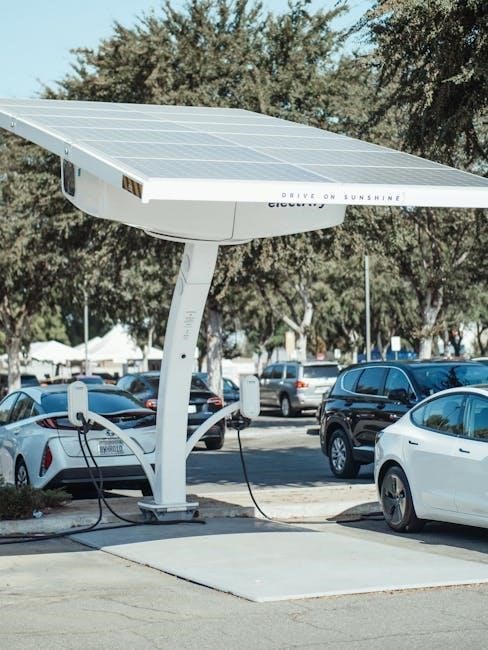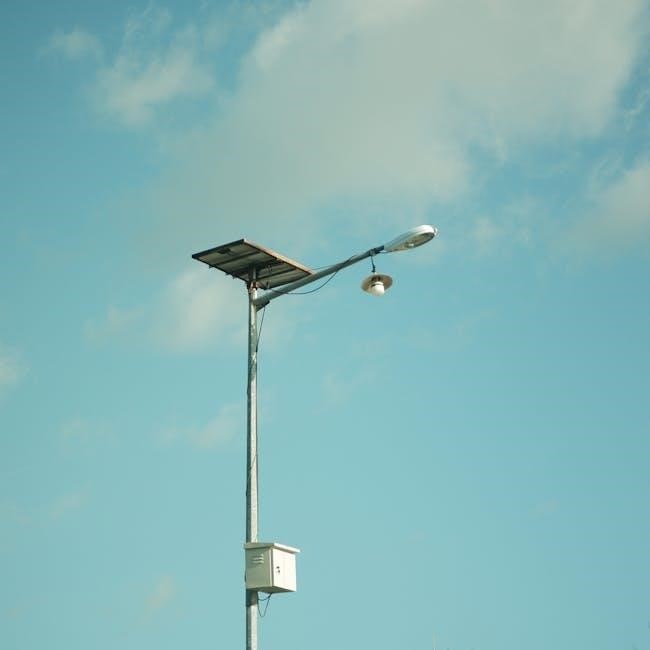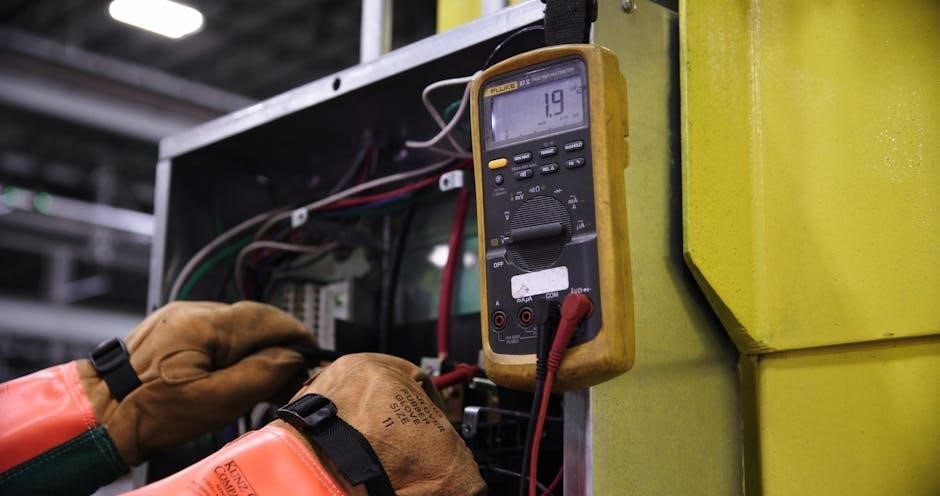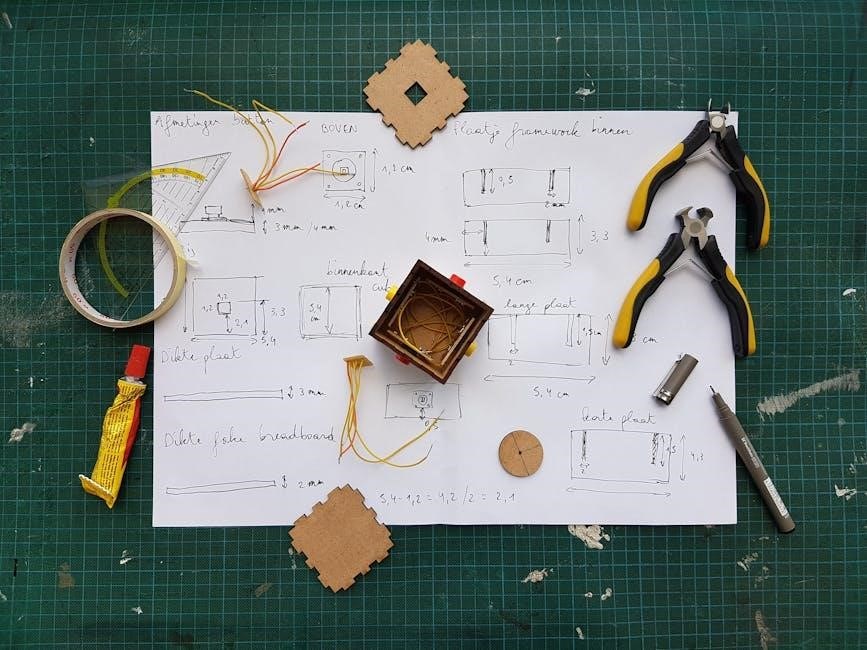
solar panel wiring diagram pdf
Understanding solar panel wiring is crucial for efficient installations; a detailed PDF diagram simplifies this process‚ offering a comprehensive guide for users of all levels․
Accessing a user manual provides step-by-step instructions‚ ensuring proper setup and maintenance of your solar system‚ preventing costly errors and maximizing energy savings․
Mastering stringing configurations impacts system performance‚ and a clear diagram is fundamental for any solar installer‚ ensuring safe and effective power direction․
What is a Solar Panel Wiring Diagram?
A solar panel wiring diagram is a visual representation of how to connect various components within a photovoltaic (PV) system․ Essentially‚ it’s a blueprint detailing the electrical connections between solar panels‚ charge controllers‚ batteries‚ and inverters․ These diagrams‚ often available as a PDF‚ are invaluable for both DIY enthusiasts and professional installers․
The diagram illustrates the specific wiring configurations – series‚ parallel‚ or series-parallel – needed to achieve the desired voltage and current levels․ A comprehensive PDF user manual will guide you through the installation process‚ ensuring correct wiring and preventing potential hazards․ Understanding these diagrams is fundamental for safe and efficient solar energy harnessing․ It provides a detailed overview‚ helping users become experts in their product’s operation and maintenance․
Proper wiring ensures panels function safely and save energy․
Why Use a PDF Wiring Diagram?
Utilizing a PDF wiring diagram offers numerous advantages for solar panel installations․ Firstly‚ it provides a readily accessible‚ portable‚ and easily shareable resource․ Secondly‚ a detailed PDF user manual ensures a step-by-step guide for installation‚ operation‚ and maintenance‚ minimizing errors․ These diagrams simplify complex wiring configurations‚ like series or parallel connections‚ crucial for achieving optimal system performance․
A clear diagram prevents significant mistakes‚ ensuring power is directed correctly and safely․ Furthermore‚ a PDF format allows for easy zooming and printing‚ facilitating on-site reference․ Accessing manufacturer’s documentation through PDFs guarantees compatibility and adherence to safety standards․ Ultimately‚ a PDF wiring diagram empowers users to become experts‚ maximizing energy savings and system longevity․
It is a straightforward installation process․

Understanding Solar Panel Components
Proper wiring relies on understanding components: panels‚ charge controllers‚ and inverters․ PDF diagrams illustrate these connections‚ ensuring efficient energy flow within your system․
Solar Panels: Types and Specifications
Selecting the correct solar panel type – monocrystalline‚ polycrystalline‚ or thin-film – is fundamental‚ and a detailed wiring diagram PDF aids in understanding their electrical characteristics․
Specifications like voltage (Vmp)‚ current (Imp)‚ open-circuit voltage (Voc)‚ and short-circuit current (Isc) are crucial for accurate wiring configurations‚ clearly outlined in these diagrams․
Understanding these specifications allows for proper series and parallel connections‚ maximizing system output․ PDF diagrams visually represent how different panel types integrate into a complete system․
Furthermore‚ the diagram will illustrate how to correctly connect panels based on their wattage and intended voltage‚ ensuring optimal performance and preventing damage․ Accurate wiring is paramount for safety and efficiency․
Therefore‚ a comprehensive wiring diagram PDF is an invaluable tool for installers and DIY enthusiasts alike‚ simplifying the complexities of solar panel integration․
Charge Controllers: PWM vs․ MPPT
Charge controllers regulate voltage from solar panels to batteries‚ and a wiring diagram PDF clarifies their integration into the system․ Two primary types exist: Pulse Width Modulation (PWM) and Maximum Power Point Tracking (MPPT)․
PWM controllers are simpler and less expensive‚ suitable for smaller systems‚ while MPPT controllers are more efficient‚ maximizing power harvest‚ especially in colder climates․
A detailed PDF diagram illustrates the wiring differences between these controllers‚ showing how they connect to panels‚ batteries‚ and loads․ Understanding these connections is vital․
MPPT controllers require careful wiring to unlock their full potential‚ and the diagram provides a visual guide to ensure correct polarity and voltage matching․ Proper configuration prevents damage․
Ultimately‚ the wiring diagram PDF serves as an essential resource for selecting and correctly implementing the appropriate charge controller for your specific solar setup․
Inverters: Grid-Tie‚ Off-Grid‚ and Hybrid
Inverters convert DC power from solar panels and batteries into usable AC power‚ and a comprehensive wiring diagram PDF is crucial for safe and efficient installation․ Three main types cater to different needs: Grid-Tie‚ Off-Grid‚ and Hybrid․
Grid-Tie inverters synchronize with the utility grid‚ allowing excess power to be sent back‚ while Off-Grid inverters create independent power systems‚ ideal for remote locations․
Hybrid inverters combine both functionalities‚ offering grid backup and self-consumption optimization․ The wiring diagram PDF clearly depicts the connections for each type․
Understanding these wiring differences is paramount‚ as incorrect connections can lead to system failure or safety hazards․ A detailed diagram illustrates grounding requirements․
Therefore‚ the PDF serves as an invaluable tool for selecting the right inverter and ensuring its proper integration into your solar power system․

Basic Solar Panel Wiring Configurations
A solar panel wiring diagram PDF illustrates series‚ parallel‚ and series-parallel connections‚ impacting voltage and current‚ crucial for system design and optimal performance․
Series Wiring: Increasing Voltage
Series wiring‚ clearly depicted in a solar panel wiring diagram PDF‚ connects panels end-to-end‚ positive to negative‚ to increase the overall system voltage․ This configuration maintains the same current as a single panel‚ but the voltages additively combine․
For example‚ connecting four 12V panels in series results in a 48V system․ This is beneficial for systems requiring higher voltages‚ like grid-tie inverters or specific charge controller inputs․
However‚ it’s vital to ensure all panels in a series string have similar specifications‚ as the lowest performing panel limits the entire string’s output․ A diagram will illustrate proper connections and highlight the importance of matching panel characteristics for optimal efficiency and safety․
Parallel Wiring: Increasing Current
Parallel wiring‚ as detailed in a solar panel wiring diagram PDF‚ connects panels positive to positive and negative to negative‚ increasing the overall system current while maintaining the same voltage as a single panel․ This configuration is ideal for situations where higher current is needed to power larger loads or charge batteries more quickly․
A diagram will visually demonstrate how to connect panels in parallel‚ ensuring correct polarity․ It’s crucial to use appropriately sized wiring and fuses to handle the increased current flow․
Unlike series wiring‚ parallel configurations are less sensitive to individual panel performance variations‚ offering greater system resilience․ However‚ a detailed PDF will emphasize the importance of using panels with similar voltage ratings for optimal performance․
Series-Parallel Wiring: Balancing Voltage and Current
Series-parallel wiring‚ clearly illustrated in a solar panel wiring diagram PDF‚ combines the benefits of both series and parallel configurations; This method involves first connecting panels in series to increase voltage‚ then connecting those series strings in parallel to boost current․
A well-designed diagram will showcase how this arrangement allows for flexibility in matching system voltage to inverter requirements while simultaneously providing sufficient current for the load․ It’s a common approach for larger solar arrays․
The PDF will highlight the importance of careful planning and accurate calculations to ensure balanced string voltages and currents‚ maximizing efficiency and preventing potential issues like overheating or component failure․

Wiring Diagrams for Common Systems
PDF wiring diagrams offer clear visuals for 12V‚ 24V‚ and 48V systems‚ simplifying installation and troubleshooting with detailed schematics for various configurations․
These guides ensure correct connections between panels‚ charge controllers‚ batteries‚ and inverters‚ optimizing performance and safety․
12V Solar Panel Wiring Diagram
A 12V solar panel wiring diagram‚ often found within a comprehensive PDF guide‚ illustrates the fundamental connections for small-scale systems‚ ideal for powering lights‚ fans‚ or charging small devices․
Typically‚ this involves connecting one or more solar panels in parallel to maintain the 12V voltage while increasing the current capacity․ The positive terminal of each panel connects to the positive input of the charge controller‚ and similarly‚ the negative terminals are linked․
The charge controller then regulates the power flow to a 12V battery‚ preventing overcharging․ A fuse is crucial‚ placed between the panels and the controller‚ and another between the controller and the battery‚ for safety․
PDF diagrams clearly show these connections‚ including wire gauges and component specifications‚ ensuring a safe and efficient 12V solar setup․ Understanding polarity is vital; reverse polarity can damage components․
24V Solar Panel Wiring Diagram
A 24V solar panel wiring diagram‚ readily available in PDF format‚ details configurations for systems requiring higher voltage‚ often used for larger appliances or more substantial energy storage․
Achieving 24V typically involves wiring two 12V panels in series – connecting the positive of one panel to the negative of the next – to double the voltage while maintaining the same current․ This series string then connects to the charge controller․
The PDF diagram will illustrate the correct polarity and the necessity of a fuse between the panels and the controller․ Proper grounding is also emphasized for safety․
Like 12V systems‚ a charge controller regulates power to the battery bank‚ and an inverter can convert the 24V DC to 120V or 240V AC for household use․ Accurate wiring‚ guided by the diagram‚ is essential․
48V Solar Panel Wiring Diagram
A 48V solar panel wiring diagram‚ typically found in PDF format‚ outlines configurations for advanced systems demanding significant power‚ often utilized in off-grid homes or commercial applications․
Reaching 48V generally requires connecting four 12V panels in series‚ or two strings of two panels in series‚ to achieve the desired voltage․ The diagram clearly illustrates this series connection process․
Crucially‚ the PDF will emphasize the importance of using appropriately sized wiring and fuses to handle the increased voltage and current․ Proper grounding techniques are also highlighted for safety․
Similar to lower voltage systems‚ a charge controller manages power flow to the battery bank‚ and an inverter converts DC to AC․ Following the diagram ensures efficient and safe operation․

Safety Precautions for Solar Panel Wiring
PDF diagrams emphasize safe DC electricity handling‚ proper grounding‚ and correct fuse/breaker selection to prevent mistakes and ensure long-term system reliability․
Working with DC Electricity
Understanding the nuances of Direct Current (DC) electricity is paramount when utilizing a solar panel wiring diagram PDF․ Unlike Alternating Current (AC) found in household outlets‚ DC presents unique hazards‚ demanding meticulous attention to safety protocols․

Always assume circuits are live‚ even after disconnection‚ and utilize insulated tools specifically designed for electrical work․ A comprehensive PDF diagram will often highlight polarity‚ crucial for preventing reverse connections that can damage components or create fire risks․
Proper personal protective equipment (PPE)‚ including insulated gloves and eye protection‚ is non-negotiable․ Refer to the diagram for voltage levels and corresponding safety measures․ Remember‚ DC arcs can be incredibly persistent and difficult to extinguish‚ making prevention the best strategy․
Proper Grounding Techniques
A solar panel wiring diagram PDF will often detail essential grounding procedures‚ vital for safety and system performance․ Grounding provides a low-resistance path for fault currents‚ minimizing electrical shock hazards and protecting equipment from damage․
Ensure all metallic components – including panel frames‚ mounting structures‚ and conduit – are securely bonded to a common grounding point․ Refer to local electrical codes for specific grounding requirements‚ as they can vary significantly․
Utilize appropriately sized grounding conductors and connections‚ as specified in the diagram and relevant standards․ Incorrect grounding can render the system ineffective and even create new hazards․ Regularly inspect grounding connections for corrosion or looseness‚ maintaining a safe and reliable system․
Fuse and Circuit Breaker Selection
A comprehensive solar panel wiring diagram PDF will highlight the critical importance of fuse and circuit breaker selection for system protection․ These devices safeguard against overcurrents‚ preventing damage to wiring‚ components‚ and potentially‚ fires․
Carefully calculate the maximum current your system can produce under various conditions‚ and choose fuses/breakers with appropriate amperage ratings․ Sizing too low leads to nuisance tripping; too high offers insufficient protection․ Consider using multiple smaller fuses instead of one large one for better granularity․
Ensure compatibility with the system voltage and wiring type․ Regularly inspect these protective devices for signs of wear or damage‚ replacing them as needed to maintain optimal safety and reliability․

Renogy Solar Panel Wiring Guide
Renogy panels are easily connected‚ even for beginners‚ with a PDF wiring diagram providing a comprehensive guide for effective setup and optimal performance․
Connecting Renogy Panels in Series
When connecting Renogy solar panels in series‚ you’re aiming to increase the overall voltage of your system while maintaining the same current․ A detailed PDF wiring diagram is invaluable here‚ illustrating the positive terminal of one panel connected to the negative terminal of the next․
This configuration is ideal when your charge controller or inverter requires a higher voltage input․ Always ensure the voltage doesn’t exceed the maximum input voltage of your equipment‚ as damage can occur․ The diagram will clearly show how to maintain polarity throughout the series connection․
Proper wire gauge selection‚ as indicated in the diagram‚ is critical to minimize voltage drop․ Remember to use fuses or circuit breakers to protect the wiring and components from overcurrent situations‚ as detailed in the Renogy documentation․
Connecting Renogy Panels in Parallel
To connect Renogy solar panels in parallel‚ a PDF wiring diagram is essential for understanding how to increase the overall current while maintaining the same voltage․ This is achieved by connecting all the positive terminals together and all the negative terminals together․
Parallel wiring is beneficial when your system requires higher amperage‚ particularly for larger loads or to compensate for shading․ The diagram will illustrate the importance of using appropriately sized wiring to handle the increased current flow‚ preventing overheating and voltage drops․
Crucially‚ ensure all panels have similar voltage ratings before connecting in parallel․ Refer to the Renogy documentation within the PDF for specific recommendations and safety precautions‚ including fuse placement for optimal protection․

Off-Grid Solar System Wiring
A simplified diagram‚ often found in a PDF‚ illustrates the core components: solar panels‚ charge controller‚ battery‚ and inverter‚ for independent power․
Understanding this layout ensures efficient energy storage and usage‚ vital for off-grid living and reliable renewable power solutions․
Solar Panels‚ Charge Controller‚ Battery‚ and Inverter
A comprehensive solar panel wiring diagram PDF meticulously details the interconnection of these four essential components․ Solar panels capture sunlight‚ converting it into DC electricity‚ which then flows to the charge controller․
The charge controller regulates this DC power‚ preventing overcharging of the battery bank – the system’s energy storage․ Batteries store the energy for later use‚ providing power when sunlight is unavailable․ Finally‚ the inverter transforms the stored DC power into usable AC electricity for powering household appliances and devices․
PDF diagrams clearly illustrate the wiring sequence‚ including proper polarity and fuse placement‚ ensuring safe and efficient operation․ Understanding these connections is paramount for a functional off-grid system‚ and a well-documented diagram is invaluable for both installation and troubleshooting․
Simplified Off-Grid System Diagram
A clear solar panel wiring diagram PDF visually represents a simplified off-grid setup‚ showcasing the core components and their connections․ Typically‚ the diagram illustrates solar panels connected in series or parallel‚ feeding into a charge controller․
From the charge controller‚ wires lead to the battery bank‚ representing the energy storage․ An inverter is then connected to the battery‚ providing AC power output․ These diagrams often include safety features like fuses and circuit breakers‚ clearly marked for proper installation․
The PDF emphasizes proper grounding techniques and polarity‚ crucial for system safety and efficiency․ Such diagrams are invaluable for DIY enthusiasts and professionals alike‚ offering a quick reference for understanding the system’s architecture․

Troubleshooting Common Wiring Issues
A solar panel wiring diagram PDF aids in identifying issues like reverse polarity‚ voltage drops‚ and loose connections‚ ensuring optimal system performance and safety․
Identifying Reverse Polarity
Reverse polarity‚ a common wiring mistake‚ occurs when the positive and negative terminals are connected incorrectly‚ potentially damaging components like the charge controller or inverter․ Utilizing a solar panel wiring diagram PDF is paramount in preventing this issue during installation‚ providing a visual guide to correct connections․
When troubleshooting‚ a diagram helps quickly pinpoint reversed connections․ Symptoms include a non-functioning system or‚ more seriously‚ blown fuses․ Carefully compare the actual wiring to the diagram‚ paying close attention to wire colors and terminal markings․ Always disconnect the power source before making any corrections to ensure safety․ Correcting reverse polarity involves simply swapping the wires at the affected connection point‚ then re-checking the diagram for accuracy before restoring power․
Dealing with Voltage Drops
Voltage drop‚ a reduction in electrical potential along a wire‚ diminishes system efficiency․ A solar panel wiring diagram PDF aids in calculating potential drops based on wire gauge and cable length‚ crucial for optimal performance․ Longer wire runs and smaller gauges exacerbate this issue‚ reducing power delivered to the battery or inverter․
To mitigate voltage drop‚ utilize thicker gauge wires‚ especially over extended distances․ The diagram helps determine the appropriate wire size for your specific system configuration․ Monitoring voltage at various points – panel output‚ charge controller input‚ and battery terminals – reveals significant drops․ Addressing this involves shortening cable runs or upgrading wire gauge‚ ensuring efficient energy transfer and maximizing system output․
Checking for Loose Connections
Loose connections represent a significant safety hazard and a primary cause of system malfunctions․ A detailed solar panel wiring diagram PDF highlights all connection points‚ facilitating systematic inspection․ Regularly examine all terminals‚ connectors‚ and splices for tightness and corrosion‚ as these impede current flow․
Visual inspection should be coupled with a voltage test; fluctuating readings often indicate a poor connection․ Gently tug on wires to confirm secure seating within connectors․ Corroded terminals require cleaning with a wire brush or replacement․ Tightening all connections ensures optimal performance‚ prevents overheating‚ and minimizes the risk of electrical fires‚ safeguarding your investment and ensuring system reliability․

Resources for Solar Panel Wiring Diagrams
Numerous online databases and manufacturer documentation offer comprehensive solar panel wiring diagram PDFs‚ aiding installers and DIY enthusiasts with system design and troubleshooting․
Online Diagram Databases
Several online platforms specialize in hosting a vast collection of solar panel wiring diagram PDFs‚ catering to diverse system configurations and component types․ These databases often allow users to search by voltage‚ panel quantity‚ or specific equipment brands like Renogy‚ streamlining the diagram-finding process․
Many websites provide free‚ downloadable diagrams‚ while others may require a subscription for access to premium content or more detailed schematics; Exploring these resources can significantly reduce installation time and minimize potential wiring errors․
Furthermore‚ community forums dedicated to solar energy often feature user-submitted diagrams and troubleshooting guides‚ offering practical insights and real-world examples․ Always verify the accuracy of diagrams from unofficial sources before implementing them in your system․
Manufacturer’s Documentation
Directly accessing the manufacturer’s documentation is paramount when seeking accurate solar panel wiring diagram PDFs․ Companies like Renogy typically provide detailed schematics specifically tailored to their products‚ ensuring compatibility and optimal performance․ These documents often include step-by-step installation guides and safety precautions․
Downloading PDFs from the official website guarantees the most up-to-date information‚ reflecting any revisions or improvements to the product design․ Utilizing this resource minimizes the risk of using outdated or incorrect wiring configurations․
Moreover‚ manufacturer’s manuals frequently offer troubleshooting tips and explanations of key components‚ empowering users to diagnose and resolve potential wiring issues effectively․ Always prioritize official documentation for reliable guidance․